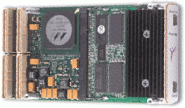CG Linux adds ATCA blade, PrPMC module
Jul 24, 2007 — by LinuxDevices Staff — from the LinuxDevices Archive — 6 views Emerson Network Power's embedded computing business (formerly Artesyn) says its flagship AdvancedTCA (ATCA) blade and Processor PMC (PrPMC) module are now supported by MontaVista's carrier-grade Linux distribution. MontaVista Linux Carrier Grade Edition (CGE) 4.0 comes standard with support for the KatanaQP blade and PmPPC7448 module, Emerson said.
Emerson Network Power's embedded computing business (formerly Artesyn) says its flagship AdvancedTCA (ATCA) blade and Processor PMC (PrPMC) module are now supported by MontaVista's carrier-grade Linux distribution. MontaVista Linux Carrier Grade Edition (CGE) 4.0 comes standard with support for the KatanaQP blade and PmPPC7448 module, Emerson said.
Support for Emerson's telecom boards appears to have been contributed to MontaVista at least in part by a dedicated MontaVista engineering team that Emerson established last month. However, the two companies have worked together on Linux ports since at least 2005, when Emerson (then Artesyn) began touting network equipment pre-installed with MontaVista, an event that made MontaVista's list of top 2006 milestones.
“Katana” means “sword” in Japanese — an apt name for a computing blade compliant with the AdvancedTCA standard. Emerson's KatanaQP (pictured above) targets WAN access, SS7/SIGTRAN signaling, media gateways, traffic processing, wireless base stations, and softswitches. It is powered by a pair of Freescale MPC7448 processors, and features four PTMC (processor “telecom” mezzanine card) expansion sites. Other featues include redundant IPMI-based system management interfaces, and a high-speed PICMG 3.1-compliant ATCA interface with ten-Gigabit Ethernet channels.
 The PmPPC7448 (pictured at right) is a PrPMC module that, like the KatanaQP, is based on MPC7448 processors. It targets control-plane applications for optical and wireless infrastructure, as well as packet processing augmentation for voice gateways and softswitches. It can be used to enhance protocol processing performance in SS7 and SIGTRAN signaling control points and gateways, MontaVista says.
The PmPPC7448 (pictured at right) is a PrPMC module that, like the KatanaQP, is based on MPC7448 processors. It targets control-plane applications for optical and wireless infrastructure, as well as packet processing augmentation for voice gateways and softswitches. It can be used to enhance protocol processing performance in SS7 and SIGTRAN signaling control points and gateways, MontaVista says.
MontaVista calls its Linux CGE 4.0 product “a field-hardened Linux distribution widely deployed in the networks of the world's leading carriers.” Touted features include the “latest 2.6 kernel,” advanced hard real-time capabilities, unique high-availability services, built-in AdvancedTCA hardware support, and an Eclipse-based integrated development platform. CGE complies with the Service Availability Forum (SA Forum) Application Interface Specifications (AIS) for high availability services, and with the Linux Foundation's Carrier Grade Linux specifications, according to the company.
Jeff Durst, Emerson program director, stated, “Linux is emerging as the dominant platform for high-availability network infrastructure products. We have created a dedicated MontaVista support team charged with giving our customers early access to the latest MontaVista Carrier Grade Edition releases, optimized and preconfigured for our telecom blades and systems. Our investment in that team is already paying dividends, as evidenced by the availability of MontaVista Linux CGE version 4.0 for our ATCA blades and PrPMC modules.”
Dan Cauchy, director of marketing at MontaVista, stated, “MontaVista Linux CGE running on Emerson's blades and modules gives NEPs a flexible, open, and proven foundation.”
MontaVista competitor Wind River has also touted CGL support for the KatanaQP.
This article was originally published on LinuxDevices.com and has been donated to the open source community by QuinStreet Inc. Please visit LinuxToday.com for up-to-date news and articles about Linux and open source.